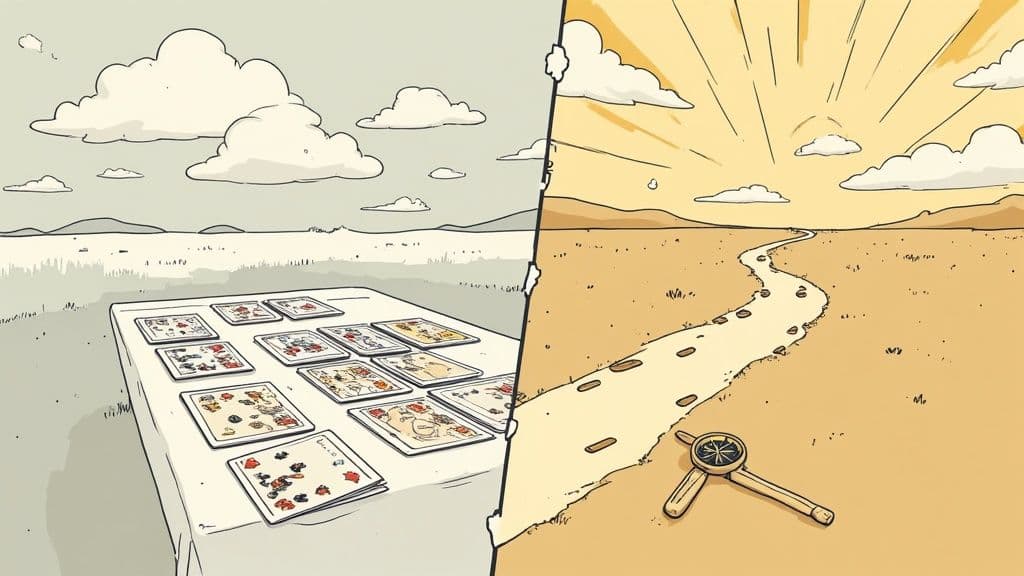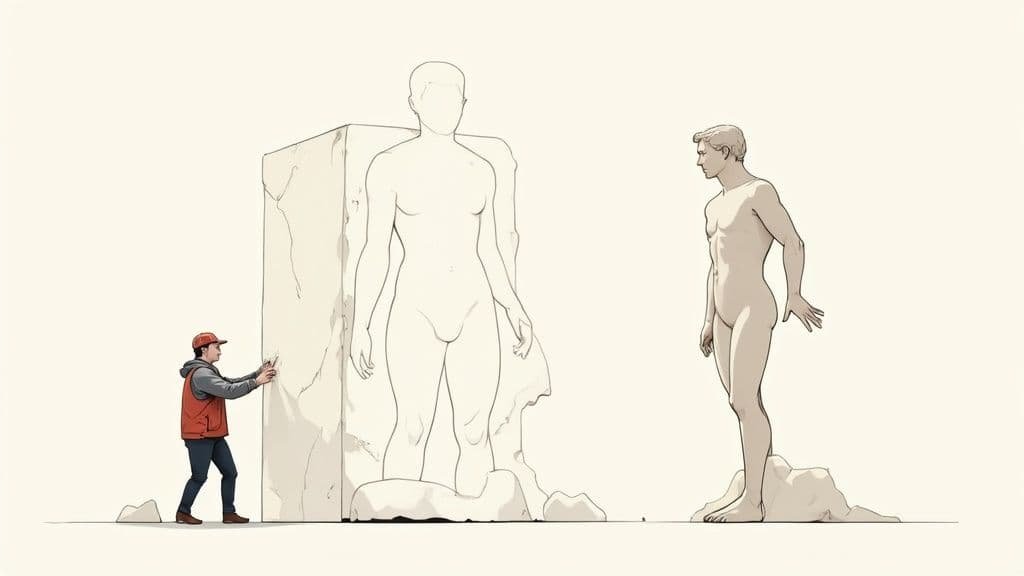Is your life already written, or are you the one shaping it? This article clarifies the difference between fate—the circumstances you’re born into—and destiny—the path you create through choice and purpose. Learn practical steps to accept what you can’t change and act on what you can.
October 29, 2025 (22d ago) — last updated November 7, 2025 (12d ago)
Fate vs Destiny: How They Differ and Why It Matters
Learn the difference between fate and destiny, how choice and purpose shape your path, and simple steps to start shaping your life today.
← Back to blog
Fate vs Destiny: How They Differ and Why It Matters
Explore what is the difference between fate and destiny. Learn how choice, free will, and your unique purpose shape the path you walk in life.

Is your life’s story already written, or are you the one holding the pen? That question gets to the heart of one of life’s biggest puzzles: the difference between fate and destiny.
The distinction, while subtle, is powerful. Think of fate as the unchangeable context of your life: the givens such as where you were born, the family you were born into, and your genetic makeup. Destiny is the path you carve within that context. It’s what you choose to do with those cards.
Why the difference matters
Understanding what’s fixed and what’s flexible helps you act with clearer intention and improves wellbeing by increasing a sense of control and purpose5. We’ll draw on real-world wisdom, notably principles from Dan Millman’s work and resources available through the Life Purpose App1.
| Aspect | Fate | Destiny |
|---|---|---|
| Control | External, largely unchangeable | Internal, influenced by choice and action |
| Nature | Given circumstances | Potential you can develop |
| Role | Starting point | Active participation |
These ideas connect to timing and the choices you make along the way. If you’re curious about how timing shapes our journey, see our article on what is divine timing.
Fate as your starting point

Reframe fate not as a rigid script but as your unique starting line—the hand you were dealt at birth. This hand includes what you couldn’t choose: genetics, family, country, and era. These are the raw materials you work with.
Picture a sculptor given a particular block of marble. The stone’s size and texture are fixed. That’s fate. What the sculptor carves from it is the creative potential you can shape.
Accepting fated circumstances stops you wasting energy fighting what you can’t change. That acceptance is the first step toward shaping your life. The past informs who you are, but it doesn’t have to be a prison. For more on this idea, see “Why Your Past Does Not Define You.”2
Understanding your starting point is a foundation within many spiritual principles that influence our journey, such as the spiritual laws explored on the Life Purpose App site.
Destiny as your active path
If fate is the hand you’re dealt, destiny is how you play the game. Destiny is the living journey you shape with each choice. It isn’t a fixed destination; it’s the potential you rise to meet.
Dan Millman frames destiny as consciously aligning with your core purpose. Using tools like the Life Purpose App to find your life number isn’t a prediction, it’s a roadmap to your highest potential1.
In Western cultures there tends to be a strong emphasis on individual agency, where personal effort is seen as a key driver of outcomes3. That cultural perspective helps explain why many people view destiny as something they can influence.
Fate and destiny in everyday life
How do these ideas show up day to day? Think of someone born with a phenomenal singing voice—that’s fate, the raw potential. Destiny is what they do with it: taking lessons, practicing daily, and having the courage to perform.
Fate hands you clay, destiny is the sculpture you create. Destiny results from your choices, actions, and sense of purpose.

When fate throws a curveball, such as an unexpected job loss, that event is outside your control. Your destiny is forged in your response. Do you see it as an end or as a new beginning? That active response is the difference between being a passenger and being the driver.
Key differences between fate and destiny
| Attribute | Fate | Destiny |
|---|---|---|
| Control | External, predetermined, largely out of your hands | Internal, shaped by choices and actions |
| Nature | Passive — what happens to you | Active — what you make happen |
| Role in life | Starting point — the cards you’re dealt | Journey — how you play those cards |
| Outcome | Can feel limiting | Represents potential and growth |
How to actively shape your destiny

Knowing the idea is one thing; putting it into practice is where change happens. Shaping your destiny means shifting from being a passenger to taking the wheel.
Start by clarifying your core purpose. Creating a personal mission statement gives a solid foundation for what truly matters to you4. Another useful step is mapping your life path using Dan Millman’s framework or the Life Purpose App; think of it as a blueprint highlighting strengths and challenges1.
With that self-awareness, set goals that align with who you are. Use a personal development plan to turn insights into action. See our personal development plan template for a practical guide.
Embracing your path forward
Stop fighting the hand you were dealt and start deciding where you want to go. Acknowledge the fated parts of your life, then use your choices to shape your destiny.
Your power isn’t in what happens to you, it’s in how you respond. Treat life’s challenges as raw ingredients for resilience and growth. Your path isn’t set in stone; it’s a canvas you can paint on, one choice at a time.
Frequently Asked Questions
Can my destiny change?
Yes. Fate gives your starting point; destiny is a living potential that evolves with every choice you make.
Is fate or destiny more important?
They’re both important and interconnected. Fate provides the raw materials, destiny is what you build with them.
How do I know if I’m on the right path?
You’ll often feel a sense of flow or authenticity when your choices align with your core purpose. Tools like the Life Purpose App can help map that alignment1.
Quick Q&A: Common questions and practical answers
Q: What’s the simplest way to tell fate and destiny apart?
A: Fate is what you’re given; destiny is what you create.
Q: What should I focus on first, acceptance or action?
A: Accept your starting point, then choose one intentional action that moves you forward.
Q: How do I begin shaping my destiny today?
A: Clarify your core purpose, set a small aligned goal, and take the first step.
Three concise Q&A sections to summarize practical next steps
Q: How do I accept my fate without feeling stuck?
A: Name the facts you can’t change, practice self-compassion, and reframe limitations as constraints that spark creativity.
Q: What’s one daily habit that shapes destiny?
A: A short, consistent practice—journaling, focused practice, or a 15-minute skill session—keeps momentum aligned with your purpose.
Q: When should I seek outside help to discover my purpose?
A: If you feel stuck for months despite trying small steps, a coach or tools like the Life Purpose App can provide clarity and actionable guidance1.
Ready to discover your unique path? The Life Purpose App offers tools based on Dan Millman’s bestselling work to help you understand your core purpose, gifts, and challenges. Find out more at https://lifepurposeapp.com.
Discover Your Life Purpose Today!
Unlock your true potential and find your life’s purpose.
